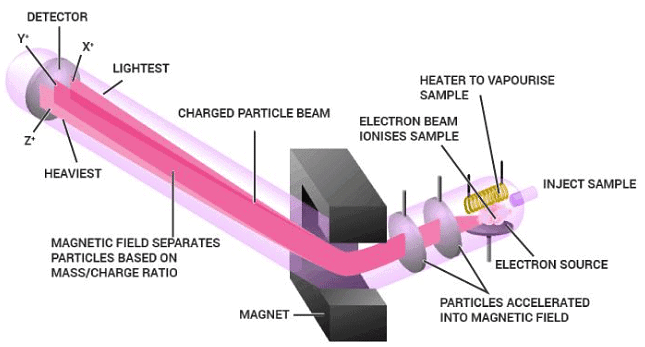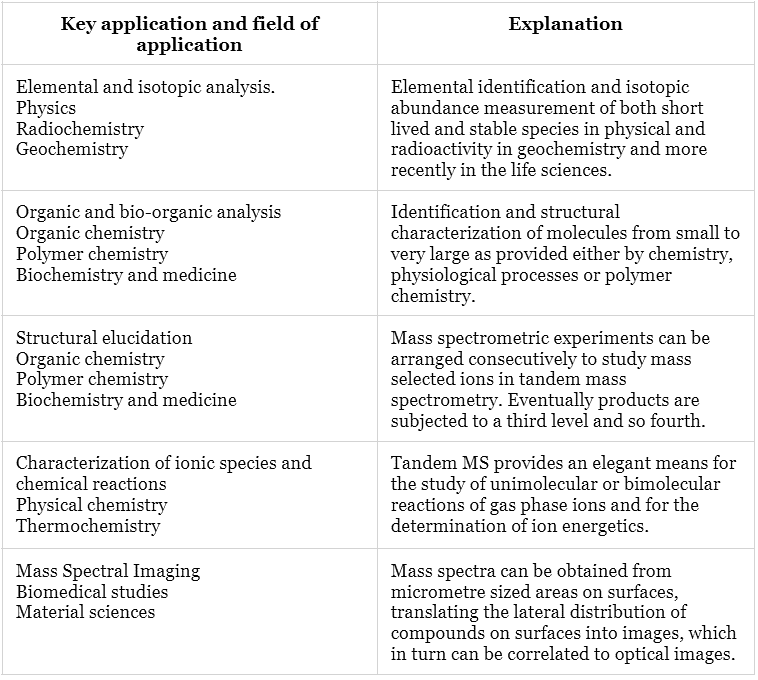Chemistry Exam > Chemistry Notes > Organic Chemistry > Mass Spectroscopy
Mass Spectroscopy | Organic Chemistry PDF Download
What is Mass Spectrometry?
Mass spectrometry is an analytical method useful for calculating the mass-to-charge ratio ( m / z) of one or more molecules in the sample. Such measurements may also often be used to determine the precise molecular weight of the sample components. Mass spectrometry is an analytical method to find the molecular mass of a compound and indirectly helped to prove the identity of isotopes.
- Principle of Mass Spectrometry: Based on Newton’s second law of motion and momentum, a mass spectrometer uses this property of matter to plot ions of varying masses on a mass spectrum. From the law, we infer how much mass is relevant to the inertia and acceleration of a body. This principle is applied to the aspect where ions with different mass to charge ratios are deflected by different angles in an electric or magnetic field.
- Mass Spectrum: A mass spectrum is a graph obtained by performing mass spectrometry. It is a relation between the mass to charge ratio and ion signal.
- Mass Spectrometry Diagram
- Inlet system
- Ionization
- Deflector
- Ion detector

Mass Spectrometry Instrumentation
Mass Spectrometry Detectors
- At different deflections a detector counts the number of ions. The data are plotted as a graph or continuum of various masses. Detectors function by recording the induced charge or current generated by an ion hitting or passing through a surface. Since the signal is very small it is possible to use an electron amplifier, Faraday cup, or ion-to-photon detector. To generate a spectrum the signal is greatly amplified.
The Mass Analyzer
- When ionized, the ions are sorted and divided according to the mass-to – charge (m / z) ratio. A variety of mass analyzers are currently available, each of which has trade-offs related to speed of operation, separation resolution and other technical criteria. The different forms in use at the Broad Institute are described in the following section. The mass analyzer often works in concert with the ion detection system.
What is a Quadrupole?
- Mass spectrometry determines the chemical by calculating the typical mass fragments formed by the ionization of the material. Test molecules are ionized by an electron beam, and the resulting molecular ion and component ions travel into a mass analyzer where their masses are measured.
- Mass spectrometry is generally considered the benchmark for identification of unknown organic chemicals because it is highly sensitive and selective, and mass spectra are easily searchable against vast reference databases.
Mass Spectrometry Instrumentation
The four main parts of mass spectrometry are discussed below:
- Ionizer – The bombarding of the sample is done by the electrons. These electrons move between cathode and anode. When the sample passes through the electron stream between the cathode and anode, electrons with high energy knock electrons out of the sample and form ions.
- Accelerator – The ions placed between a set of charged parallel plates get attracted to one plate and repel from the other plate. The acceleration speed can be controlled by adjusting the charge on the plates.
- Deflector – Magnetic field deflects ions based on its charge and mass. If an ion is heavy or has two or more positive charges, then it is least deflected. If an ion is light or has one positive charge, then it is deflected the most.
- Detector – The ions with correct charge and mass move to the detector. the ratio of mass to charge is analyzed through the ion that hits the detector.
How does Mass Spectrometry Work?
- In a regular mass spectrometer, we initially have the material to be analyzed, but we need it to be ionized to pass through the spectrometer with enough energy. Thus, the sample is bombarded by electrons to ionize it.
- This ionized beam is now passed through a series of electric or magnetic fields depending on the type of the sample and its properties. The ions are deflected by the field through which they are passed through in such a way that the ions with the same mass to signal ratio will follow the same path to the detector.
- These charged and deflected ions are now incident onto a detector which is capable of distinguishing the charged particles falling on it. Based on the mass spectrum produced by the charged ions, we can identify the atoms or molecules constituting the sample by comparing them with known masses or through a characteristic fragmentation pattern.
Applications of Mass Spectrometry
- Mass spectrometry is an efficient method to elucidate the chemical composition of a sample or molecule. More recently, it has been used to classify biological products, in particular proteins and protein complexes, in a number of species. Usually, mass spectrometers can be used to classify unknown substances by molecular weight measurement, to measure known compounds, and to determine the structure and chemical properties of molecules.
- Due to its capability to distinguish between substances, Mass spectrometry is used to determine unknown substances.
- To identify the isotopes of a substance.
- In analytical laboratories that study the chemical, physical and biological properties of substances. It is favored over several other analytical techniques as it has less background interference since it is performed in a vacuum.
Fields of Application of Mass Spectrometry

Mass Spectrometry Advantages and Disadvantages
- Mass spectrometry is used for both qualitative and quantitative study of chemical substances. These can be used to classify a sample’s elements and isotopes, to determine molecular masses, and as a tool for helping to classify chemical structures. This can calculate the purity of the samples and the molar mass.
- A big advantage of mass spec is that it is incredibly sensitive (parts per million) over many other techniques. It is an excellent tool for identifying or confirming the presence of unknown components in a sample. The disadvantages of mass spec are that identifying hydrocarbons that produce similar ions is not very good and it is not able to separate optical and geometric isomers. The disadvantages are offset by combining MS with other methods , for example gas chromatography. One disadvantage of mass spectrometry is over hydrocarbons. The method fails to distinguish between hydrocarbons producing similarly fragmented ions. Thus, here we have seen a brief description of what a mass spectrometer is, its structure and how it functions.
The document Mass Spectroscopy | Organic Chemistry is a part of the Chemistry Course Organic Chemistry.
All you need of Chemistry at this link: Chemistry
|
39 videos|92 docs|46 tests
|
Related Searches
















